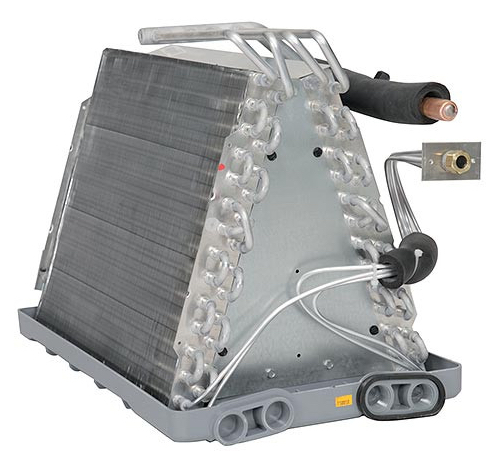
Should I Have A Heat Exchanger Installed?
Have you ever wondered about how an energy-efficient home breathes? If you’ve gone through all the trouble of sealing up doors, windows, and minuscule cracks to keep the AC or heat in and the outside air out; if our homes are now like airtight spaceships, when do we run out of air?
The fact is that we don’t. It would be very difficult to make a home so airtight that someone might actually suffocate as a result of energy-efficient planning. There are always little cracks, eaves in the attic to allow enough air to breathe comfortably. But it is true that the more energy-efficient a home gets, the more likely we are to breathe stale air. Air that has been breathed and cycled through the filter and AC and pushed back out into our rooms to be breathed again. And just like a space movie where the air “gets bad” after a while, so too does the air in our home. Especially in the winter. This is why we have heat exchangers, and we recommend every home that uses radiant heat have one installed.
Winter Air in an Energy-Efficient Home
If you live somewhere that gets cold, you don’t have to be told that air can get stale indoors in the winter. It’s a combination of the heating process and the fact that no one wants to open up the doors or windows to let a chilling blast of freezing-fresh air into the house. At first, heating up the house feels cozy. We huddle in with our families, make hot cocoa, and maybe light a fire in the fireplace in addition to turning up the furnace. If you want to make your heating system more efficient, you can hire a service provider who can build a sunroom in your house. The heat of the sun would pass through the glass windows and roof to make your house warmer during winters. You can search for such companies on the web by “sunrooms company Edmonton” or with the name of the place you live in.
But your ventilation system isn’t necessarily pulling in new air when the vents blow. It’s intaking the same warm air from inside the home, re-heating it, and blowing it out. Which creates the cycle we mentioned earlier. Over time, the air inside your home becomes stale with exhaled carbon dioxide, with kitchen fumes, with wisps of smoke that didn’t quite make it up the chimney. It can become dry from heat treatment or humid from shower steam. And it stops smelling nice.
This, in fact, is what spring cleaning is all about: cycling the stale warm air out of a house and letting fresh spring air in. That’s why we associate spring with such incredibly good smells, because it’s a nice change from closed-up houses. Especially back in the days before there were any home ventilation systems at all. Of course, most of us can’t make it all the way to spring breathing the same air inside our homes.
What Happens When Home Air is Recycled Too Many Times
When air gets stale in the warm-air-recycling system we just described, it doesn’t just start to smell bad and feel bad. It also becomes bad for you. People have become sick breathing the same recycled air too many times, just like space movies. This can happen when not enough oxygen is brought in compared to the carbon dioxide being created by fires and people breathing. Sure, opening the door a few times a day for work and school commuting helps. But not as much as you’d think because the house is closed up the vast majority of the time.
Inside that air cycling over and over in your home isn’t just carbon dioxide either. There are allergens that are still floating around from the fall when you closed up. There is dust and dust mites that are growing in numbers in your un-cleaned air. Even if your HVAC filter is new and good (and, let’s face it, most people don’t have a fresh HFAC filter in there), the filter can’t get everything and your air in the home is not being refreshed.
Soon, the air inside your home can actually be more polluted with indoor contaminants like aeration from cooking and built-up dust that it’s officially dirtier than the air outside. And in today’s world, that’s not a good sign.
What a Heat Exchanger / Air Exchanger Does to Help Home Air
So, what does this all have to do with a heat exchanger? It’s possible you have already guessed. A heat exchanger, also known as an air exchanger, is a mechanism that trades stale in-home air out for fresh outside air. You may be thinking “I can do that just by opening a window”. Sure, of course you can. But can you do it without blasting cold air into your cozy-warm home? That is exactly what the heat exchanger was designed to do.
A heat exchanger is actually just a special set of ducts backed by blower fans (in and out) and hatches to close up when necessary. But most interestingly, and most usefully, the heat exchanger is designed to trade out the air in a way that doesn’t freeze the house. First, it’s contained and hidden instead of being an open window in your living room. Second, it carefully filters, warms, and delivers the air to your HVAC system without ever exposing the house to a cold draft.
Heat exchangers work with an air intake inside the home to suck in stale air and a suction fan to pull outside air into its ducts. Inside the ducts of the heat exchanger, the outside air is first filtered, then warmed by passing by the warm-air ducts and possibly running past the furnace just like how your inside air warms up. It then joins the regular flow of air to your house, refreshing the oxygen and taking the place of the stale air that was removed.
Why Every Home Needs a Heat Exchanger Installed
The heat exchanger runs constantly, or at least when the HVAC is on, to ensure that modern homes do not suffer from the same poor air quality of our spring-cleaning ancestors. The heat exchanger ensures that fresh and freshly warmed air is constantly flowing into our homes while stale air is taken out so that our homes do not become high-pollutant, allergen-hoarding, dust-rich environments that make winter colds so much worse.
If your home has felt stuffy and uncomfortable in the winter, or even in a hot summer when you didn’t want to let in the heat, then what you need is a heat exchanger, sometimes called an air exchanger. All homes should have one because it is an essential part of air quality safety and maintenance in keeping your home and family healthy. Contact us today to talk about how you can work a heat exchanger installation into your next home renovation plans.

